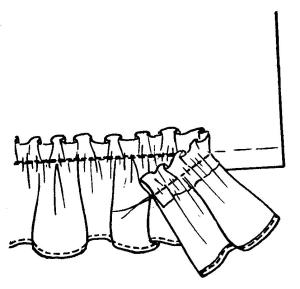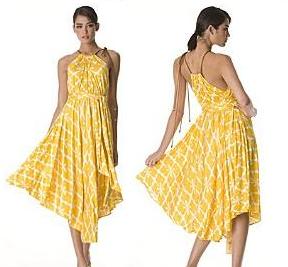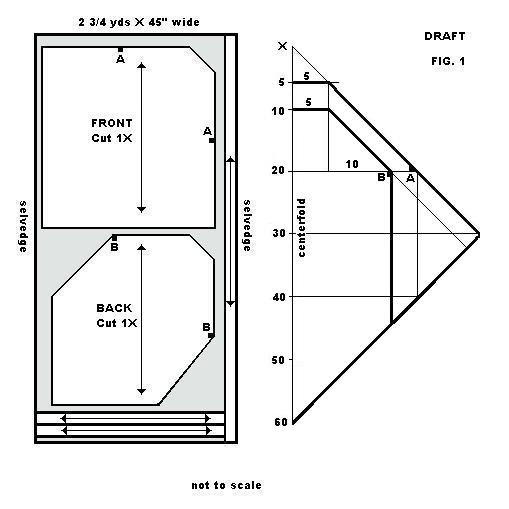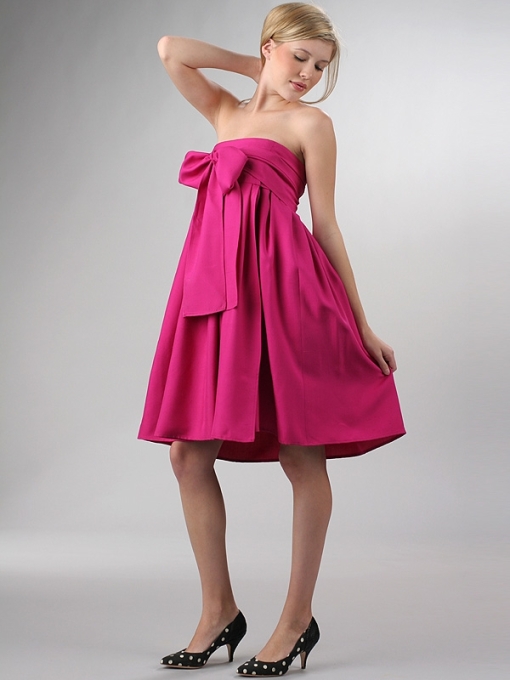 Featured: Simplicity
Featured: Simplicity
The button-front “chemise” sundress— the quintessential of summer attire – is easy to wear, unrestrictive and yet not without that “sophisticated look”. This summer, you’ll find the sundresses will be both elegant and appealing. And I am sure that because of its easy patterndraft, this lovely addition to your summer wardrobe will inspire you with your favourite fashion fabric.
You will need:
- 1 ½ yds. [1.5 m] of Fashion fabric, 60” [150 cm]wide
- 1 ¼ yds. [1.2 m] of Fusible interfacing 24” [60 cm] wide
- 12 buttons, 7/8” [22 mm] dia., line 34
- Coordinating thread
- Kraft paper
MEASUREMENTS
Bust – measure around fullest part of chest, just under the arms.
Hips – measure around fullest part of seat, about 8” [20 cm] below waistline.
Back waist length – measure distance from nape of neck to waistline
PATTERN

A-B = back waist length
B-C = 2 times back waist length (or desired finished length**)
B-D = 4” [10cm]
Square across all points.
D-E = 1/2 of hip or bust measurement (whichever is the greater)
Square up and down from E to locate G, H.
I = half distance of A to B.
Square across to locate J.
I-K = 2” [5cm]; square across to locate L.
J-M = 3” [7.5 cm]
N = half distance of I to J.
Square down from N to locate O, P, and R.
N-Q = 1” [2.5 cm]; I-S = 1” [2.5 cm]; join M to Q.
T = half distance of B to P.
Square up and down from T to locate U and V.
L-W = 3” [7.5 cm]
H-X = 3” [7.5 cm]
Join W and X with a straight line.
Measure 1” [2.5 cm] on either side of P. Shape sideseam by joining Q and R with a smooth curve passing through the points on either side of P.
Measure ½” [12 mm] either side of T. Make a shaping dart by joining U and V with a smooth curve passing through the points on either side of T. (optional)
PINTUCKS
Trace out A-G-K-L.
Add ½” [12mm] at K and L. Join new points with a straight line.
Divide rectangle horizontally with 1 ½” [4 cm] intervals (3 in total) to create the pintucks.
Each pintuck is ½” [12 mm] wide with 1” [25 mm] spacing. (see diagram)

Trace out on fold S-Q-R-O-C for the dress back.
Trace out J-N-O-R-Q-M for the dress front.
Trace out L-W-X-N for the front placket.
Trace out on fold K-L-J-I for the dress facing.
Add ½” [12 mm] seam allowances to all pattern pieces.
Add 1 ¼” [ 32 mm] hem allowance to dress back and fronts.
**Design Note: This patterndraft can be shorten to waistline for a smart summer camisole.
CUTTING
 Cut BACK 1X self on fold
Cut BACK 1X self on fold
Cut FRONTS 2X self
Cut FACING 1X self on fold; 1X interfacing on fold
Cut PLACKET 2X self; 2X interfacing.
Cut PINTUCKS 1X self on fold
Cut 2 SHOULDER STRAPS = 16” long X 1” wide
[40 cm x 2.5 cm]
ASSEMBLY
- Make 2 shoulder straps ¼” [6mm] wide.
- Iron fusible interfacing to wrong side of dress facing and both placket pieces, following manufacturer’s directions.
- Make the pintuck border. Beginning at the top edge, turn under 1 ½” [4cm] and press. Stitch ½” [12 mm] parallel to folded edge. From stitching, turn under 1” [25mm] and press. Stitch ½” [12mm] parallel to pressed edge. From stitching, turn under 1” [25 mm] and press. Set aside.
- Stitch the suppression darts on the back piece. (optional)
- Stitch fronts to back along side seams. Press seam open.
- Align and match bottom edge of pintuck border to top edge of dress. Pin/baste with right sides facing together. Machine stitch. Grade seam allowance and press upward.
- From face side, baste along seamline (while tucking in the seam allowance) to complete last pintuck. From last pressed fold, stitch ½” [12 mm] parallel to seamline.
- Press all pintucks downward on the face side of the dress.
- Set shoulder straps in place on front and back. Baste to top edge of border.
- Align and match dress facing to top edge of dress ensuring the straps are caught in the seam. Pin/baste in place. Machine stitch the seam. Grade seam allowance and press to one side. Understitch facing. Finish bottom of facing by turning under ¼” [6 mm] then topstitching. Turn facing to inside of dress.
- With right side of placket to wrong side of dress fronts, pin/baste placket to each front (allowing for seam allowance at top and hem). Stitch seam and press to one side.
- On opposite side of placket, turn under seam allowance and press flat. Fold the short ends of the placket back on itself and stitch across top and bottom. Trim corners, then turn plackets right side out. Align the pressed edge to the row of machine stitching and topstitch closed.
- On the right front placket, divide the length equally for 12 1-inch [2.5 cm] vertical buttonholes spaced 3 inches [7.5 cm] apart from the top. Position the first buttonhole 1″ [2.5cm] from the top of the dress front opening.
- On the left front placket, sew on the buttons.
 Courtesy: Vogue
Courtesy: Vogue This pattern is drafted
This pattern is drafted  Dress Back – cut 1X self on fold
Dress Back – cut 1X self on fold Turn upper edge of dress down 1 inch to make a gathered ruffle, and baste. Apply the bias fold tape on top of the raw edge of the turned dress edge. At this time, place one shoulder strap under the top edge of the bias fold tape and locate it in the middle of the front pieces. Make a
Turn upper edge of dress down 1 inch to make a gathered ruffle, and baste. Apply the bias fold tape on top of the raw edge of the turned dress edge. At this time, place one shoulder strap under the top edge of the bias fold tape and locate it in the middle of the front pieces. Make a  On the bottom of the dress, apply the flounce to the bottom edge.
On the bottom of the dress, apply the flounce to the bottom edge. 











